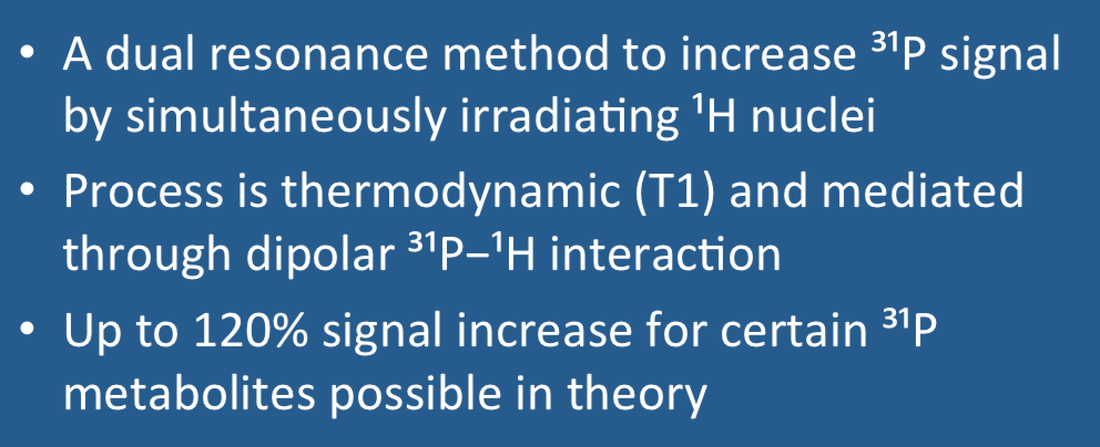Nuclear Overhauser Enhancement (NOE) is superficially similar to proton decoupling in that it involves selective RF-irradiation of ¹H nuclei leading to improved peak definition in a ³¹P spectrum. Indeed, both proton decoupling and NOE are usually performed together in the same MRS experiment. Three important differences should be noted, however:
- The NOE effect is due to a dipolar (through space) interaction of ³¹P and ¹H spins, while decoupling is mediated by J-coupling (through bonds).
- RF-irradiation of protons in NOE is performed in the period before ³¹P signal acquisition, while decoupling is performed during signal acquisition.
- NOE is a spin-lattice (T1) process that takes time to develop; decoupling is instantaneous.
|
|
The mechanism underlying NOE is somewhat complex, hopefully made more understandable by the video (left). In brief, saturating the ¹H resonance in a system where protons undergo dipolar interactions with ³¹P nuclei upsets the thermodynamic balance between up and down spin states. As the population difference in ¹H spins driven to zero by RF-saturation, the population difference of ³¹P increases in response, with augmentation of P signal. In theory, maximum enhancement of 120% is possible, but in practice 40-80% values are typical.
|
|
As with proton decoupling, both continuous wave (narrowband) and pulsed block (broadband) RF-irradiation schemes (e.g. WALTZ-4) are possible. The latter methods are more commonly used in clinical MRS to minimize tissue heating. The NOE effect is improved when combined with proton decoupling, as proton saturation is maintained during the data acquisition period.
|
Advanced Discussion (show/hide)»
No supplementary material yet. Check back soon!
References
Anderson WA, Freeman R. Influence of a second radiofrequency field on high-resolution nuclear magnetic resonance spectra. J Chem Phys 1962; 37:85-103.
Li CW, Negendank WG, Murphy-Boesch J, et al. Molar quantitation of hepatic metabolites in vivo in proton-decoupled, nuclear Overhauser effect enhanced ³¹P NMR spectra localized by three-dimensional chemical shift imaging. NMR Biomed 1996; 9:141-155.
Overhauser AW. Polarization of nuclei in metals. Phys Rev 1953; 92:411-415. (First description by Overhauser of his now eponymous effect, used to explain how nuclei in a metal may have their spin polarizations increased when electrons in the conduction band are saturated.)
Reich HJ. The Nuclear Overhauser Effect. Syllabus for Course 605. University of Wisconsin, Madison, 2014. Available at this link.
Anderson WA, Freeman R. Influence of a second radiofrequency field on high-resolution nuclear magnetic resonance spectra. J Chem Phys 1962; 37:85-103.
Li CW, Negendank WG, Murphy-Boesch J, et al. Molar quantitation of hepatic metabolites in vivo in proton-decoupled, nuclear Overhauser effect enhanced ³¹P NMR spectra localized by three-dimensional chemical shift imaging. NMR Biomed 1996; 9:141-155.
Overhauser AW. Polarization of nuclei in metals. Phys Rev 1953; 92:411-415. (First description by Overhauser of his now eponymous effect, used to explain how nuclei in a metal may have their spin polarizations increased when electrons in the conduction band are saturated.)
Reich HJ. The Nuclear Overhauser Effect. Syllabus for Course 605. University of Wisconsin, Madison, 2014. Available at this link.
Related Questions
What is decoupling? Is it required for phosphorus spectroscopy?
What is decoupling? Is it required for phosphorus spectroscopy?

